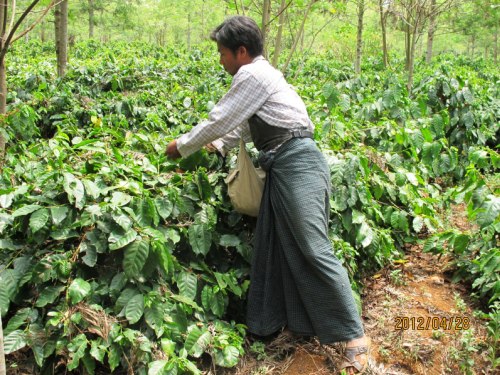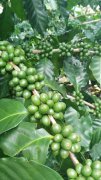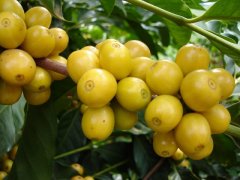Brazil Bahia Bashiya-Santo Antonio Chateau San Antonio half-sun drying beans
Professional barista communication, please pay attention to coffee workshop (Weixin Official Accounts cafe_style )

Bahia, Brazil-Santo Antônio San Antonio Manor Semi-Sunned Beans
Brazil is currently the world's largest coffee producer-48 billion 95 million bags in 2010, more than 1/3 of global production!
Coffee was first introduced to Brazil in the early 18th century. In 1727, the Brazilian government sent a handsome army officer to secretly bring coffee seeds back to Brazil from French Guiana on the grounds of mediating border disputes. It is said that the wife of the governor of French Guiana at that time was deeply fascinated by this officer, so she secretly sent coffee seeds to him in a bouquet at a farewell dinner. At present, Brazil has two million hectares of land used to grow coffee. Over 70% of the largest crop is Arabica, and these beans end up in the hands of large bakers in various countries, known as Santos (named after the export port of Santos, not the production area). Brazil has also proved capable of producing fine coffee and small batches of coffee, local fine coffee is not necessarily only available to small-scale coffee farmers, Brazil's main coffee producing areas are Sul de Minas South, Matas de Minas Southeast Forest, Cerrado, Chapadas de Minas Minas North Central Cemetery, Mogiana Mogiana, Paraná Parana Province, Bahia Province. There are traditional varieties and varieties, such as Bourbon, Mondo Novo, Icatú Ikatu, Kaduai, Iapar, cultivated Kadai. These beans were previously washed, but more and more people use natural drying and semi-sun, which are used in the hope of showing the different characteristics of coffee beans in the process, and some larger estates even use each treatment. Harvest times vary from place to place in Brazil, and our beans from Brazil are usually shipped between October and April.
The Brazilian Specialty Coffee Association (BSCA) is the biggest promoter both internationally and nationally, dedicated to improving the quality of coffee beans and coffee agriculture in Brazil. Internationally, it helps promote good coffee in Brazil and helps Brazilian coffee farmers bring coffee beans to the quality required by the global specialty coffee market. Domestically, it helps coffee farmers to continuously improve their farming practices and ensures good social welfare for farm workers.

Santo Antônio San Antonio is a small estate located on the slopes of Piatã, Bahia province, with an average annual temperature of 21 ° C. It belongs to the diamond plateau area. The current owner Antônio Macedo Souza inherited his father's land. At that time, the production of coffee trees was not much. Antonio gave up planting until 1998, Antonia received help from the local coffee farmers association (ASCAMP) to reverse the fate of this small estate. ASCAMP is a local association established in Piata to assist coffee farmers who do not have the land to invest in coffee. Antonio joined this association and increased the number of coffee trees in the garden to 6,000. With the concerted efforts of the whole family, the business gradually stabilized and became the main source of income for the family. Most of the work on the estate is done by family members, and only during harvest season will additional workers be hired. Harvest season is generally from July to September. Ripe red coffee cherries are carefully selected every day, processed and then dried in the sun in the farm's bean drying field. They are turned 18-20 times a day. After drying, they are numbered according to batches and stored separately for future sale.
Property Characteristics: Farms
Farm Name: Santo Antônio Farm
Farmer Coffee Farmer: Antônio Macedo Souza
City: Piatã
Region: Chapada Diamantina (Bahia) Diamond Plateau (Bahia)
Country: Brazil Brazil
Altitude Altitude: 1,300 m
Soil:Sandy and clay
Farm Size Farm area: 240 ha
Coffee growing area Coffee growing area: 52 ha

Certification: None None
Coffee Characteristics: Coffee characteristics
Variety: Catuaí
Processing System: Pulped Natural
Appearance: 16~17 mesh
Top Jury Descriptions Judge's comments: Cinnamon 60 seconds from the start of a pop
aroma/flavor: almond, nutmeg, cinnamon, spice, persimmon, licorice, blueberry, carambola, peanut, subtle vanilla ice cream,
Acid complex: citric acid, raspberry acid, red plum, mint, tartaric acid in red wine,
Complexity and other: sugar cane sweet, low complexity, smooth taste excellent ester,
Date of cup test: May 28, 2011
Dry aroma: 9
Wet aroma: 8
Clean: 9
Brightness: 8
Taste: 9
Balance: 10
Complexity: 10
Sweetness: 9
Acid: 8
Aftermath: 9
Cup score: 89
Important Notice :
前街咖啡 FrontStreet Coffee has moved to new addredd:
FrontStreet Coffee Address: 315,Donghua East Road,GuangZhou
Tel:020 38364473
- Prev

Brazil Minas Ipanema Ipanema Bourbon with pulp half-day drying bean cup test data
For the exchange of professional baristas, please follow the coffee workshop (Wechat official account cafe_style) Minas Ipanema Ipanema Bourbon with pulp half sun dried beans (UTZ) about this batch of Brazilian Ipanema Ipanema, the manor is located in Minas gias region, Brazil, the farm scale is very large and has exclusive processing and drying equipment, and there are creative marketing companies that establish brands.
- Next

Brazil Bourbon Champion Manor Sunburn Yellow Bourbon/Yellow Bourbon Introduction
Professional barista communication Please pay attention to coffee workshop (Weixin Official Accounts cafe_style ) Brazil ~ Champion Manor Sun-baked yellow bourbon/yellow bourbon Brazilian yellow bourbon coffee, Cerrado region of Brazil in South America, rare yellow bourbon coffee, each bag is accompanied by ID certificate, indicating the name of the manor, and the name of the owner is marked with
Related
- Does Rose Summer choose Blue, Green or Red? Detailed explanation of Rose Summer Coffee plots and Classification in Panamanian Jade Manor
- What is the difference between the origin, producing area, processing plant, cooperative and manor of coffee beans?
- How fine does the espresso powder fit? how to grind the espresso?
- Sca coffee roasting degree color card coffee roasting degree 8 roasting color values what do you mean?
- The practice of lattes: how to make lattes at home
- Introduction to Indonesian Fine Coffee beans-- Java Coffee producing area of Indonesian Arabica Coffee
- How much will the flavor of light and medium roasted rose summer be expressed? What baking level is rose summer suitable for?
- Introduction to the characteristics of washing, sun-drying or wet-planing coffee commonly used in Mantenin, Indonesia
- Price characteristics of Arabica Coffee Bean Starbucks introduction to Manning Coffee Bean Taste producing area Variety Manor
- What is the authentic Yega flavor? What are the flavor characteristics of the really excellent Yejasuffi coffee beans?

